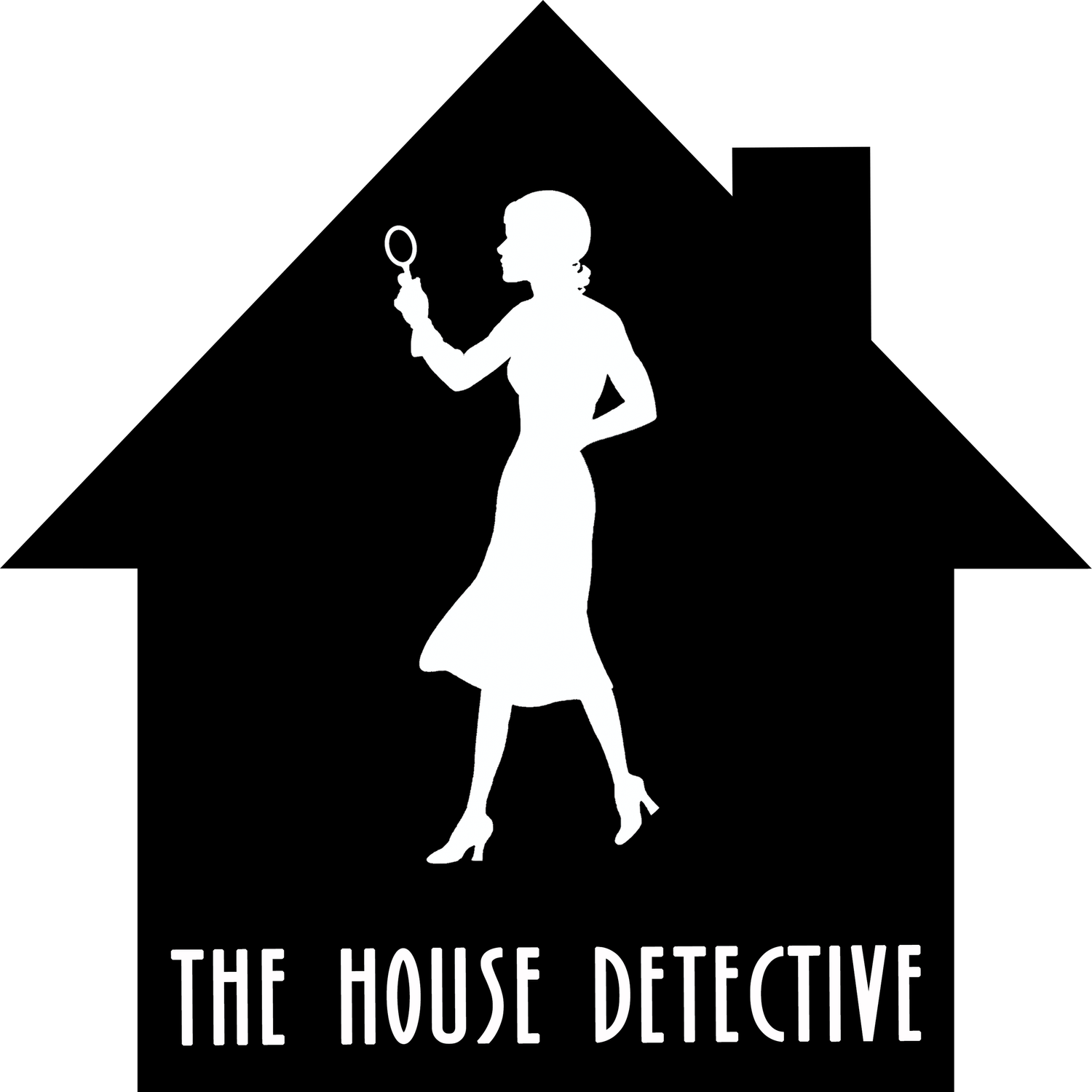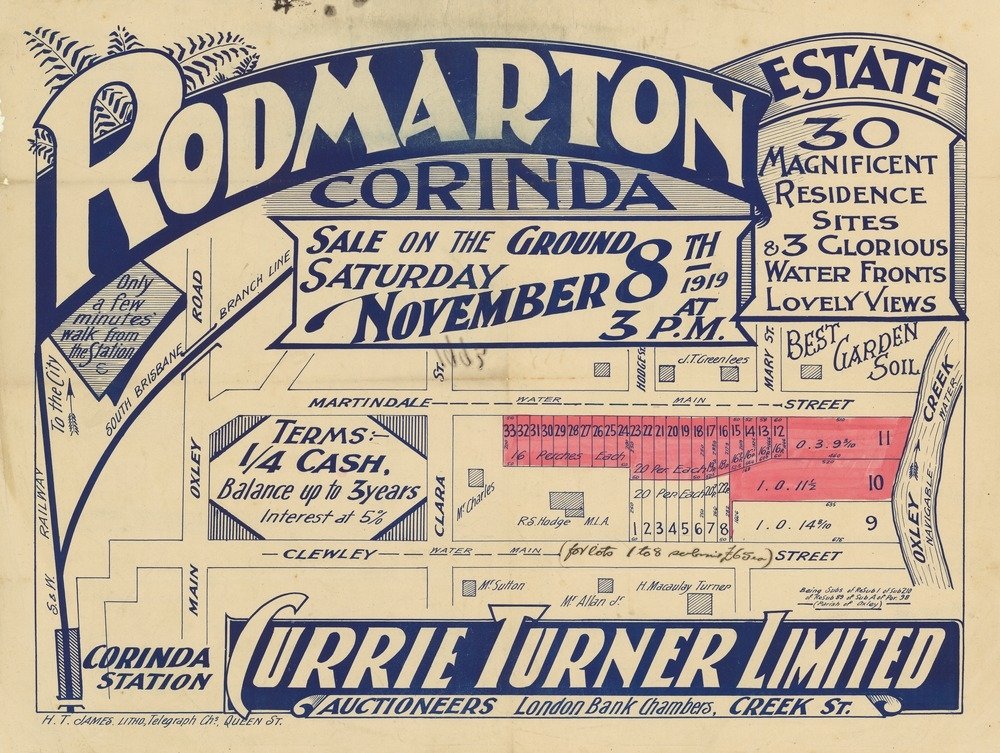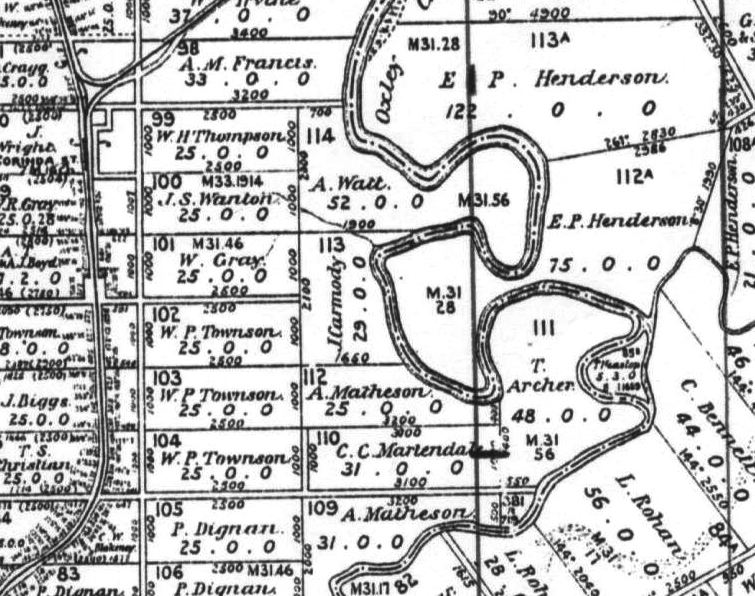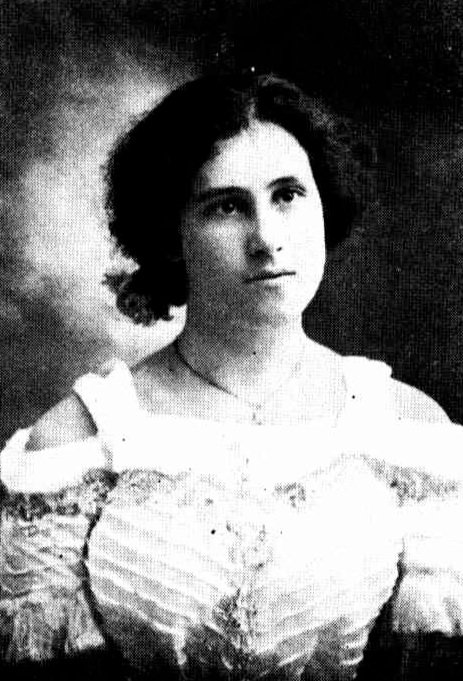LYNNE GROVE HOUSE, CORINDA
Lynne Grove House in 1918
Lynne Grove House was built about 1883 by Robert Francis Hassall as a family home. Thomas Murray Hall was the next owner and he and his family lived there for a quarter of a century. The next chapter of the house is the most intriguing however, as it was purchased by an incredible woman, Laura Duncan. Laura managed a cattle property in western Queensland and purchased the residence off Thomas Hall to use as her city residence. During the First World War, she donates her house for use as Corinda Infants’ Home, which was established to care for children whose families couldn't support them.
Map showing the extent of Brisbane in 1844, shortly after the penal colony closed (Brisbane City Council Archives)
SUBURB HISTORY
Whilst it was in operation, settlement within 50 miles (approximately 80.5km) of the Moreton Bay Penal Colony was prohibited. However, from 1838, the Penal Colony in Moreton Bay began to wind down, with the number of convicts being greatly reduced prior to its complete closure in 1839. On 10 February 1842, the Brisbane area was officially opened up for free settlement.
When Queensland separated from New South Wales in 1859 to become its own state, the Crown in the right of the State of Queensland now owned all the land except that which had previously been granted to individuals. The newly formed Queensland government then began to sell the vacant Crown land to free settlers, without any recognition of its traditional owners.
The areas now known as Chelmer, Graceville, Sherwood and Corinda had been part of Boyland's Pocket, a colonial leasehold sheep and cattle property owned by Captain Thomas Boyland. However, Boyland declined to purchase the land when it was offered for sale and the area was subdivided and purchased by numerous people, primarily for farm land. Various crops, including maize, lucerne, oats, arrowroot, potatoes, cotton and sugar, were grown.
On 5 October 1874, the railway line between Ipswich and Oxley West (now Sherwood) opened and was extended to Oxley Point (now Chelmer) the following year. Access from Brisbane city to these suburbs was further improved when the rail connection between Ipswich and Brisbane was fully linked with the opening of the Albert Bridge at Indooroopilly in 1876, replacing a ferry service. A branch line was also built between the Ipswich line and the coal wharves at South Brisbane and the station at this point was called South Brisbane Junction. In 1888, it was renamed Corinda, which is thought to have come from a local property owned by Sir Arthur Palmer, which he had in turn named after his pastoral station near Aramac.
A 1919 advertisement for a new estate at Corinda, showing the location of the train station and the South and Western and South Brisbane Junction Railway lines (State Library of Queensland)
THE LAND
On 3 March 1862, James Carmody took advantage of the early land sales in Brisbane and purchased Portion 113 in the Parish of Oxley, County of Stanley. This portion measured twenty nine acres and Carmody paid a pound an acre. He doesn’t seem to have ever lived on this land however, so perhaps bought it as an investment, or to farm the land.
Just over four years later, on 1 June 1866, the whole of the twenty nine acres of Portion 113 were transferred to farmer, Robert Donaldson. However, Donaldson resided on the other side of Oxley Creek, at Rocklea, so he too never lived on the land. By September 1882, Donaldson had subdivided the land into six smaller allotments and had begun to sell them off. Subdivisions 1 to 5 were purchased by members of the Hassall family, whilst Donaldson retained Subdivision 6 for himself. Subdivision 1, which included the current location of Lynne Grove House, was purchased by Robert Francis Hassall on 30 September 1882.
Two years later, Robert Hassall’s father, Reverend James Samuel Hassall, and brother, James Charles Hassall, purchased Subdivisions 2 and 3, respectively. Robert’s family were devoted Anglicans and James Samuel Hassall was the first minister in the Sherwood district, serving St Matthew’s at Sherwood from 1876 until his retirement in 1899. Robert’s grandfather, Thomas Hassall, and great grandfathers, Roland Hassall and Samuel Marsden, were also clergymen and missionaries. Robert however, became a registered surveyor.
Map showing location of James Carmody's land grant on Oxley Creek
THE HOUSE
In October 1879, James Samuel Hassall presided over the marriage of his son Robert to widow, Helena Hannah Walton (née) Ransom at St Paul’s Church, Ipswich. The couple initially lived with Helena’s parents at Ipswich, where they had their first child, Emily Frances Dixon Hassall. They then lived in Wharf Street, Ipswich, where they had a son, Robert Ransom Hassall. A search of newspaper articles from around this date shows that in February 1883, Robert advertised for farm labourers while still living at Wharf Street in Ipswich. Then, by June 1883, mail was being addressed to him at a place called ‘Lingrove’, Oxley. At that time, the land extending from today’s Chelmer south to Oxley was all known as Oxley, so it could refer to the current house. By 1887, this same Lingrove is described as being on Oxley Creek and a short walk from South Brisbane Junction (this station opened in 1884 and was renamed Corinda Station in 1888). All this information confirms to me that I have the right house!
Robert Francis Hassall
Robert and his family must have moved into Lingrove between February and June 1883. The Post Office Directories show that the previous owners of the land had not resided there; it had been used only for farming, so this means that Lynne Grove house was built sometime between when Robert purchased the land in September 1882, and June 1883. In September 1885, Robert also buys Subdivision 4 from Donaldson, increasing his land holding by another five acres. By November 1887, when Lingrove is advertised for sale, he also owns Subdivision 5. Robert and his family relocated to Esk around this date, where he died on 25 June 1888, aged only 33. Helena only outlived him by a year, dying in 1889 aged 34. They were both buried at St Matthews Cemetery at Sherwood and their name lives on in nearby Hassall Street.
Various mentions of Hassall and “Lingrove” in newspaper notices
Ad for sale of Lingrove contents, June 1887 (left) and Lingrove itself, November 1887 (right)
In August the following year, Thomas Murray Hall purchases Lingrove, which was still situated in its original five acres of land. Thomas was an accountant and moved from New South Wales to Brisbane around the time he purchased the residence. Like many houses of the era, over the twenty five years that the Hall family resided there, Lynne Grove saw many births, deaths and marriages. In March 1890, Thomas’ wife, Annie Eliza (née Hulle) gave birth to a daughter, Doris Hilda, at Lynne Grove. In 1891, their eight year old daughter, Leila May, died of croup at the family home. Their daughters, Ethel Annie and Eda Marion were both married at St Matthew’s Church, Sherwood, and held their receptions at Lynne Grove. Thomas Hall moved into politics and after serving as Chairman of the Sherwood Divisional Board, he became an Alderman of the Brisbane City Council. He was also a member of the Legislative Council of Queensland.
Thomas and Annie Hall’s daughter, Eda Marion, who held her wedding reception at Lynne Grove
By 1913, some of the large farming allotments around Lynne Grove are being sold off as estate developments. One of these was the “Lynne Grove Estate”, which consisted of 40 residential lots on Lynne Grove Avenue. In June 1914, Lynne Grove was purchased by Laura Duncan, although it was not officially transferred until 1 December 1914. The Hall family continued to reside in Corinda however, moving to a residence “Belbowrie” on Donaldson Street.
Advertisement for the sale of Lynne Grove Estate on Lynne Grove Avenue, 1913
Laura Duncan was a remarkable woman, who seems to have been well ahead of her time. She was born on 25 August 1875 to an English solicitor, Charles Davis, and his Australian born wife, Maria Finch, née Heney. After growing up near Sydney, in the late 1890s, Laura was living with her sister Millicent on her and her husband’s property at Birdsville in Queensland. She met her husband, William Duncan here. William was a Scottish immigrant, who managed a 881km2 cattle property west of Windorah, Mooraberrie. Laura and William married in 1898 and purchased Mooraberrie in 1906. After her husband’s death the following year, Laura took over the running of the cattle station, as well as raising the couple’s three surviving children. Laura strove to develop a first class Shorthorn herd and to pioneer other aspects of the beef trade in south-west Queensland. In 1940, she transferred the property to her daughter, Laura Lothian Duncan, and the two women ran it together. Laura purchased Lynne Grove as her city residence, staying there when she came to town, but otherwise remaining at Mooraberrie.
Laura Duncan
Shortly after purchasing Lynne Grove, Laura hosted a Red Cross day for children at her residence in September 1914. This event was a sign of things to come, as in 1915, she made the philanthropic decision to offer the use of Lynne Grove for the establishment of a home for infants. One imagines that the loss of her only son and first born child when he was only four years old, must have impacted on her interest in saving the lives of children. The Corinda Infants’ Home was managed by a committee and Laura acted as patroness. It’s goal was to save the lives of children and although the exact criteria for admission is not recorded, it seems to have been established in response to many parents being unable to care for them during the war.
In 1917 Laura Duncan took on the Queensland Government, challenging them in court over the mandatory acquisition of over 500 cattle from Mooraberrie. The case was eventually decided against her in 1919, but she had established her reputation as a determined woman, willing to fight for justice. She seems to have utilised these traits in running the infant’s home and when appealing for financial assistance for it’s operation. Despite originally only loaning Lynne Grove for twelve months, the infants home operated there for four years.
An interior view of Lynne Grove House in 1918, when it was the Corinda Infants' Home. This was one of the enclosed verandahs, used as a nursery.
The Rudd family bought Lynne Grove from Laura in November 1923 and remained there for twenty years. The McDonald, McKellar, and Reid families then call Lynne Grove home. Kenneth James Brown then bought the property in 1970. Over the next three years, he subdivided the five acres into smaller allotments, creating the cul-de-sac and allotment size which exists today.
Lynne Grove House in 1946
Lynne Grove House as it looks today
NOTES
This is only an extract from the full history I uncovered for this house. References citing the sources of the information contained in this report have been omitted from this online version to make it easier to read. Some images and maps have also been cropped to show details more clearly. Please contact me if you would the details of any references, or if you want to know where to find the full size versions of the images and maps.
Want me to uncover the story of YOUR house?
I research the history of houses all over Australia. What secrets will your home have to tell??
View more information on my packages and prices here
Read more about some other houses that I have researched here
Get in touch with me here
You can also follow my research discoveries, history and adventures on Facebook, Instagram and YouTube


















